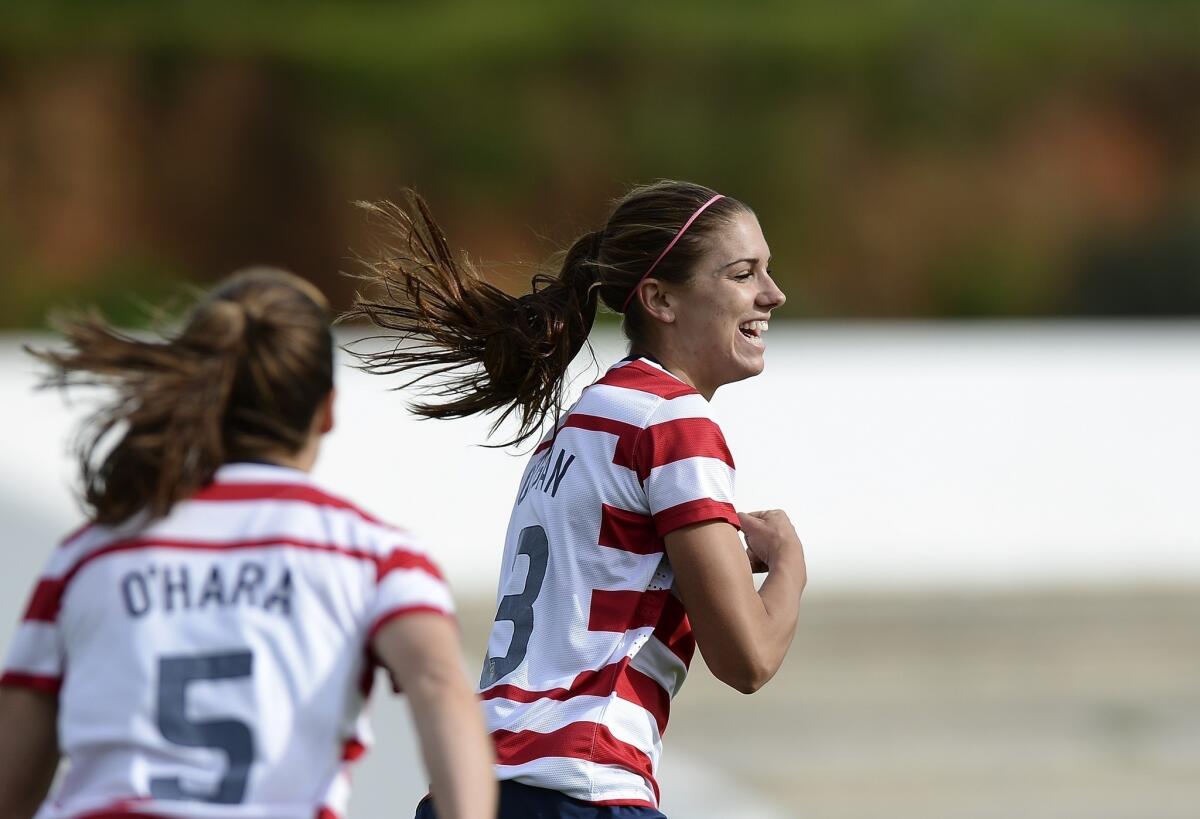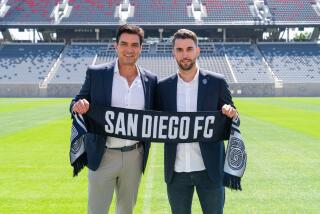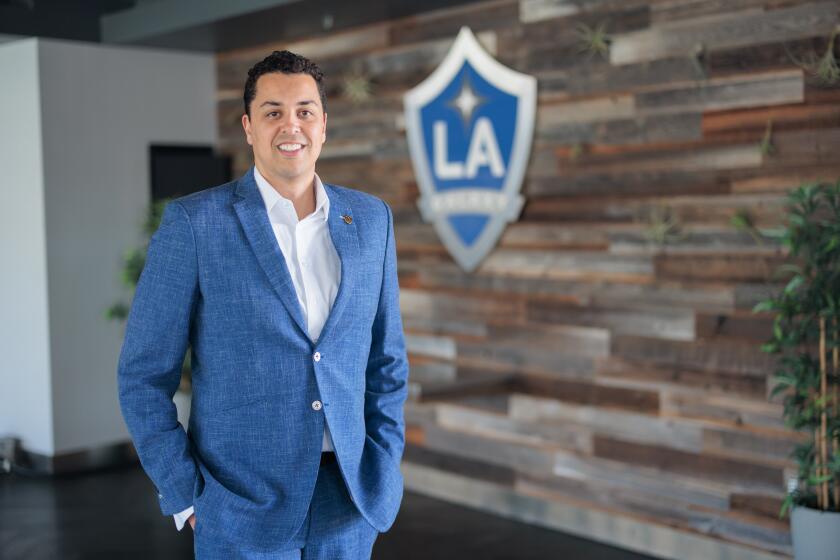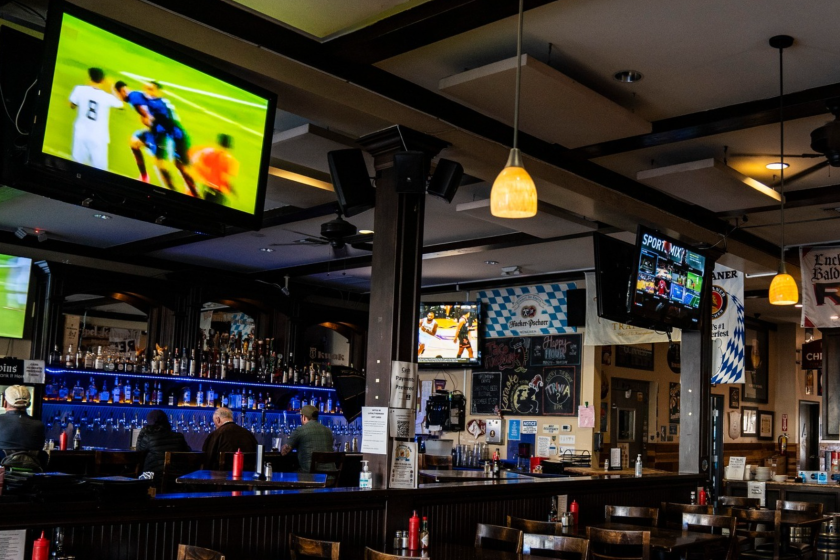New womenâs soccer league hopes slow approach is key to success

Shawnee Mission District Stadium in Overland Park, Kansas, isnât the kind of place most people associate with sporting history. A fake-turf football field ringed by a synthetic track and grandstands seating just 6,150, the nondescript stadiumâs main tenants are a pair of local high schools.
But Shawnee Mission played host Saturday to the inaugural match of the National Womenâs Soccer League, a star-studded eight-team professional league that is promising to change the landscape for the sport in North America.
Weâve been down this road before, of course. In April 2001 â less than two years after the U.S. women won a World Cup title before a crowd of more than 90,000 at the Rose Bowl â the eight-team Womenâs United Soccer Assn. began play. It lost $100 million, drowning in a pool of red ink after just three seasons.
In March 2009 â less than a year after the U.S. women won an Olympic title in Beijing â Womenâs Professional Soccer began play with seven teams. It, too, lasted just three seasons, averaging fewer than 4,000 fans a game before disagreements between the league and some club owners forced it to fold.
Now comes the NWSL, which began play before a sellout crowd Saturday â eight months after the U.S. women won their third consecutive Olympic title in London. And naturally league officials are promising things will be different this time around.
âObviously the structureâs different,â says Executive Director Cheryl Bailey. âWhen you take a look at the National Womenâs Soccer League, we are set up with a foundation not only financially but in terms of the players that are playing in the league. Itâs very different than the previous two.â
Established with considerable help from U.S. Soccer, the league also has the support of both the Canadian and Mexican soccer federations. The three organizations will pay the salaries of up to 54 national team members who participate in the league, lifting a huge financial burden off the backs of club owners who will get the services of such players as Alex Morgan, Abby Wambach, Christine Sinclair and Maribel Dominguez for free.
Teams will then have to squeeze the rest of their rosters under the leagueâs modest $200,000 salary cap, with most of those 100-plus slots going to still-developing players who previously had to choose between small professional leagues abroad or playing for free at home after their collegiate eligibility expired.
The salaries for the 3 1/2-month season â more than $30,000 for some U.S. national team players but close to minimum wage for those at the bottom of the roster â are just a fraction of what players can earn in Europe. But the chance to stay close to home and build something that may eventually present even more opportunities for the womenâs game was worth the sacrifice to some.
âItâs a unique opportunity,â says Dominguez, a striker with the Mexican national team and in the NWSL with the Chicago Red Stars. Dominguez, who played in the WUSA as well as with two teams in Spain, once found opportunities at home so scare for women she signed a two-year deal with a second-division menâs team only to have FIFA step in and block the move.
âWe, as Mexican players, are happy above all about this chance,â she says. âNot just one or two, but 13 or 14 Mexican players can return to the United States. This is great.
âUnfortunately our country doesnât have a professional league, a league where we can keep growing and keep developing. For now the focus is on being here and taking maximum advantage of the chance to promote the womenâs game and work to make it better.â
Another change from previous leagues is the NWSLâs decision to ratchet down expectations. Six of its eight stadiums have capacities of fewer than 6,200, for instance, and the league is still negotiating a national TV deal.
âThe plan is to put in some good roots right now and create a league thatâs going to be sustainable,â Bailey says. âYou donât do that with a lot of rapid change. You do that with building with what you have and then adding to it.â
After watching the first two attempts at a professional womenâs league collapse, most of the NWSLâs players support the go-slow approach.
âThese first couple of years are going to be tough,â says Sinclair, captain of the Canadian national team and the third-leading scorer in womenâs soccer history. âBut if the league can survive these first couple of years and then through the [2015] World Cup, hopefully the league can thrive.â
Sinclair, who participated in both the WUSA and WPS, will play in the NWSL for the Portland Thorns, where her teammates will include Morgan, another WPS alum who sees the new league as key to both improving the play of North Americaâs three national teams while building the game at the grassroots level.
âI want to support it for the next generation,â Morgan says. âI want the young girls to ⌠know that they can play professional soccer and maybe not be one of the 20 players on the national team but they can still be a professional soccer player when they grow up.
âThatâs why I wanted to stay in the league. Once players see that itâs stable, theyâll come back from Europe and want to play and want to support this league.â
twitter.com/kbaxter11








